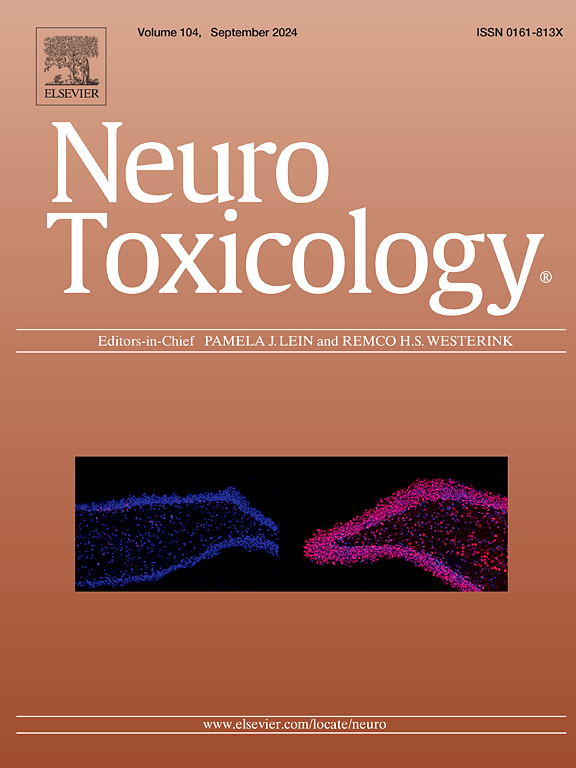HSV-1 糖蛋白 D 和氢氧化铝对人类神经母细胞瘤细胞的联合作用:对DNA氧化损伤、细胞凋亡和表观遗传修饰的启示
IF 3.9
3区 医学
Q2 NEUROSCIENCES
引用次数: 0
摘要
单纯疱疹病毒1型(HSV-1)感染是一个重要的全球健康问题,因为该病毒能够逃避细胞凋亡并在周围神经系统中建立终身潜伏期。造成这些影响的具体病毒成分尚不清楚,需要对其分子影响进行个别检查。本研究的重点是研究重组HSV-1糖蛋白D(一种进入宿主细胞所必需的病毒蛋白)和/或氢氧化铝(一种已知的神经毒性物质)对SH-SY5Y神经母细胞瘤细胞活性氧(ROS)产生、凋亡标志物和表观遗传修饰的影响。以HSV-1 gD和氢氧化铝的抑制浓度20 (IC20)值为标准,分别建立实验组。测量细胞内ROS水平、氧化DNA损伤以及关键凋亡蛋白的表达和活性。此外,我们还评估了整体DNA甲基化、组蛋白H3和H4乙酰化以及组蛋白去乙酰化酶(HDAC3和HDAC8)的活性。研究结果显示,HSV-1 gD和氢氧化铝均能独立增加SH-SY5Y细胞的ROS生成并诱导细胞凋亡。值得注意的是,表观遗传标记发生了显著变化,包括整体DNA甲基化和组蛋白乙酰化水平下降。这些表观遗传修饰提示氢氧化铝和HSV-1 gD的神经毒性作用的潜在潜在机制。除了传统认为HSV-1 gD是一种抗凋亡因子外,我们的研究结果表明,它也可能有助于神经毒性。这项研究为病毒成分与神经毒性药物之间的分子相互作用提供了新的见解,并强调了表观遗传调控在神经元细胞死亡中的重要性。本文章由计算机程序翻译,如有差异,请以英文原文为准。
The combined effects of HSV-1 glycoprotein D and aluminum hydroxide on human neuroblastoma cells: Insights into oxidative DNA damage, apoptosis, and epigenetic modifications
Herpes simplex virus type 1 (HSV-1) infections are a significant global health concern due to the virus's ability to evade apoptosis and establish lifelong latency in the peripheral nervous system. The specific viral components responsible for these effects remain unclear, necessitating individual examination of their molecular impacts. This study focused on investigating the effects of recombinant HSV-1 glycoprotein D (HSV-1 gD), a viral protein essential for host cell entry, and/or aluminum hydroxide, a known neurotoxic agent, on reactive oxygen species (ROS) production, apoptotic markers, and epigenetic modifications in SH-SY5Y neuroblastoma cells. Using inhibitory concentration 20 (IC20) values for HSV-1 gD and aluminum hydroxide, experimental groups were established. Intracellular ROS levels, oxidative DNA damage, and the expression and activity of key apoptotic proteins were measured. Additionally, global DNA methylation, histone H3 and H4 acetylation, and the activities of histone deacetylases (HDAC3 and HDAC8) were evaluated. Results of the study showed that both HSV-1 gD and aluminum hydroxide independently increased ROS production and induced apoptosis in SH-SY5Y cells. Notably, significant alterations in epigenetic markers were observed, including decreased global DNA methylation and histone acetylation levels. These epigenetic modifications suggest potential underlying mechanisms for the neurotoxic effects of aluminum hydroxide and HSV-1 gD. In addition to the traditional suggestions for HSV-1 gD as an anti-apoptotic factor, our findings indicate that it may also contribute to neurotoxicity. This study provides new insights into the molecular interactions between viral components and neurotoxic agents and emphasizes the importance of epigenetic regulation in neuronal cell death.
求助全文
通过发布文献求助,成功后即可免费获取论文全文。
去求助
来源期刊

Neurotoxicology
医学-毒理学
CiteScore
6.80
自引率
5.90%
发文量
161
审稿时长
70 days
期刊介绍:
NeuroToxicology specializes in publishing the best peer-reviewed original research papers dealing with the effects of toxic substances on the nervous system of humans and experimental animals of all ages. The Journal emphasizes papers dealing with the neurotoxic effects of environmentally significant chemical hazards, manufactured drugs and naturally occurring compounds.
 求助内容:
求助内容: 应助结果提醒方式:
应助结果提醒方式:


